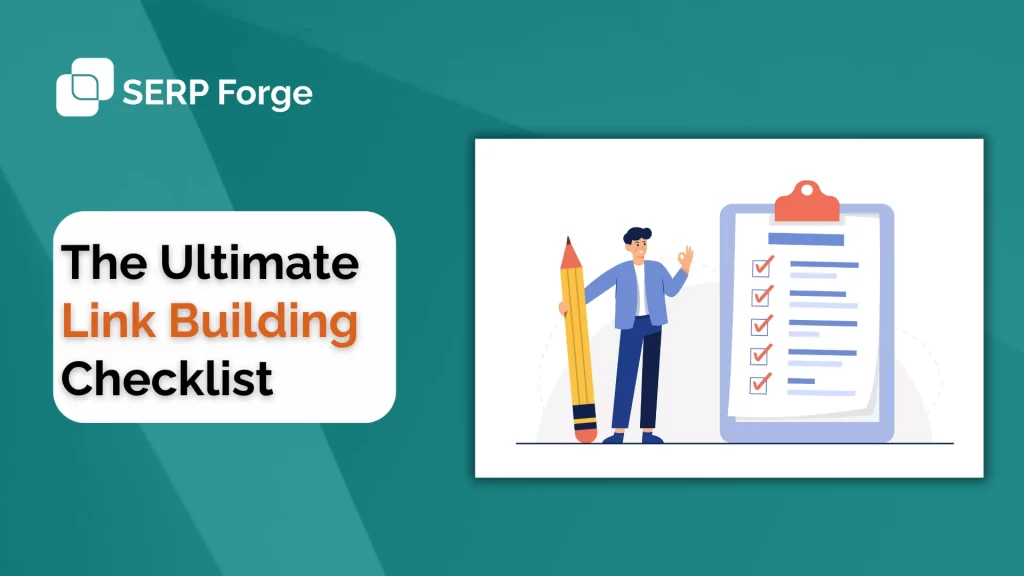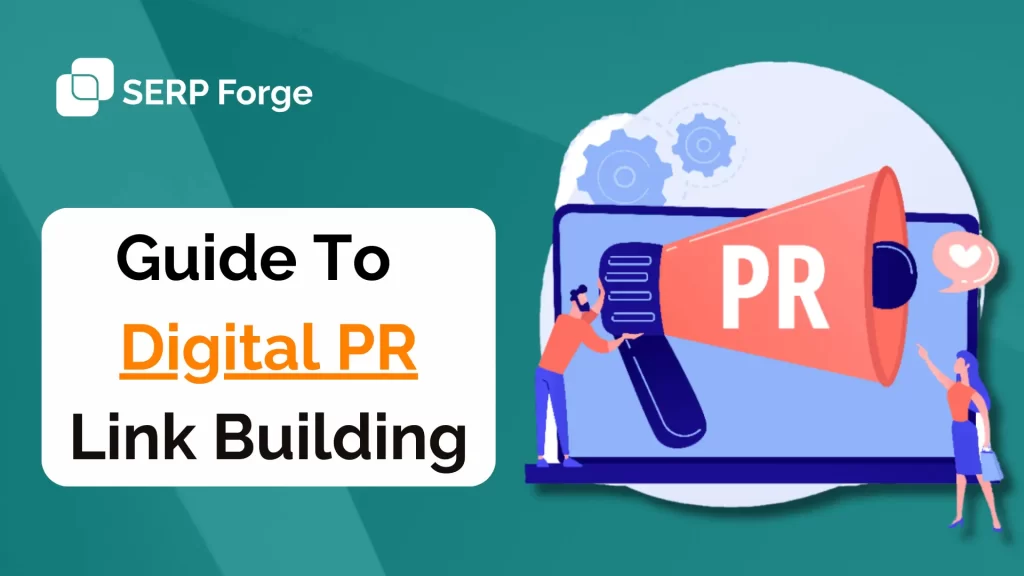Since link building is one of the top 2 ranking factors of Google, it is what majorly decides your page rankings.
What does it mean? Well, it simply means that you can’t take things lightly when it comes to link building.
Each strategy you perform and each step you take decides the rankings of your website.
It’s like a two-sided sword where taking the right steps can get your rankings up, whereas, wrong steps can take your rankings down.
But don’t worry, we are here to help.
In this post, we are going to put all the pieces together and teach you about the entire link building process right from the start to the end. In other words, it’s a link building checklist.
Let’s go.
What is a link building checklist
Link building is not a one-time thing.
Link building is an ongoing process where you constantly have to take steps to get links from the target website.
Well, you see, a link building checklist can be said to be a list of questions you need to ask yourself to get the latter.
This link building checklist tells you about the exact steps to start your link building process and get links.
In short, this checklist is the starting point for your link building process.
Here’s a quick list of what you’ll get from this checklist:
- Step-by-step process guide to earn high-quality backlinks
- Learn about the strategies you can use to get those links
- Learn about everything from choosing prospects and forming strategies to outreaching and monitoring the progress
Link building checklist
Okay, now that we know what this checklist is all about, it’s time to proceed with it.
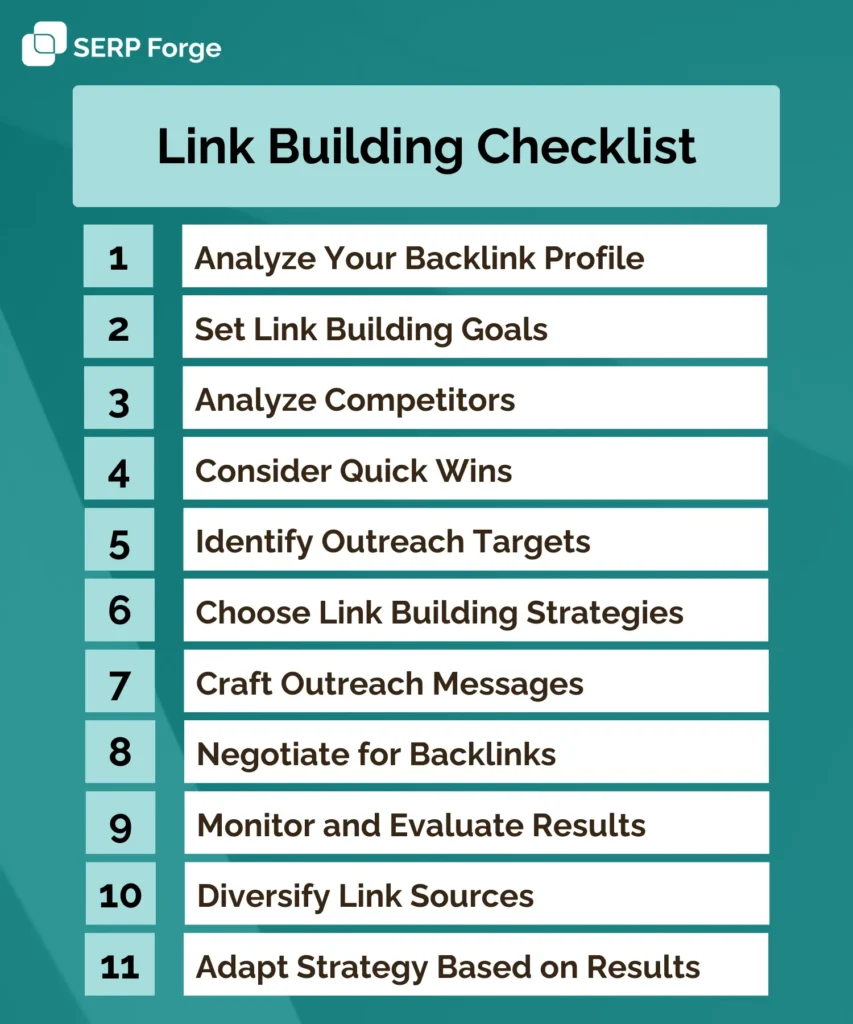
1. Have you analyzed your current backlink profile
This step is all about identifying the problems and the gaps.
Before you set your goals for anything, you need to first understand what you need. Why? That’s because goals are set up on things that you need.
The backlink profile analysis tells you about what you need.
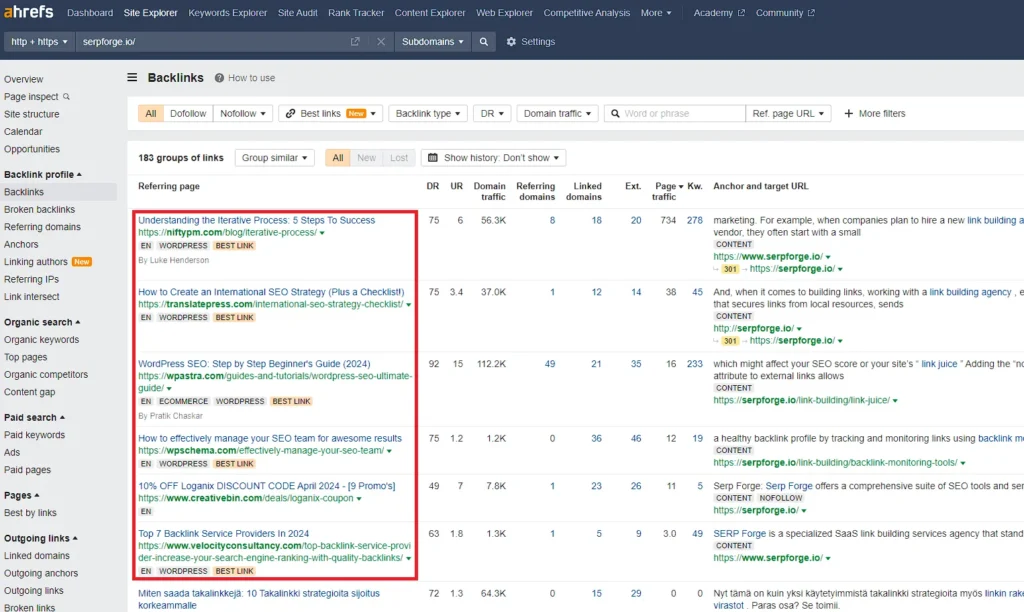
That is why the very first thing you must do is analyze your current backlink profile so that you can understand what exactly needs to be fixed and what your current needs are.
Why should you analyze your current backlink profile
A backlink profile analysis tells you what your current backlink profile is.
In other words, it tells you about the websites that are linking to you, how many Dofollow links you have, which page has the most backlinks, which websites are sending spam links, and so on.
This helps you understand your current position.
How can you analyze your current backlink profile
Well, there are many free and paid tools like Ahrefs and Semrush that let you analyze your backlinks profile.

All you need to do is enter your website domain and the tool will analyze and present a list of websites that are linking to you with their tags, DA score, etc.
2. What is the goal of your link building campaign
Now that you’ve successfully performed the first step, you can move to the next step and set your goals.
After analyzing your backlinks profile, you can understand what the current gaps in your backlinks profile are, which link needs to be removed, which page needs more backlinks, which page received the highest number of links, and so on.
This overall helps you set correct goals for your website.
Ask yourself:
What do I need to achieve with my link building
Some examples of it might include:
- I want to get high quality backlinks to my website from a targeted group of websites
- I want to increase the number of backlinks to a particular web page
- I want to increase the search ranking for X keyword by getting more links
- I want to Improve the reputation of my brand by getting links from reputable websites
Just remember that these are just a few examples. You can get more specific and set goals based on your website needs.
Also, it is wise to write down your goals and put them on paper so that you can review your goals regularly and make adjustments in the future.
3. Have you analyzed your competitors
Now this is where the real link building process begins.
Once you set your goals, you will understand what you need to do.
Now, it’s time to identify your competitors and analyze their backlinks profiles.
Why analyze your competitors
You will find that the best way to start any business is to analyze your competitors.
Your competitors run similar businesses and compete with you in search engines.
That’s why it’s always wise to analyze your competitors before making any strategies.
Get a list of their backlinks and try to understand what works for them. Know where they get the most backlinks and which page attracts the most links.
Once you have all the details of their backlinks profile, ask yourself a few questions:
- What is the one thing they do that brings the most links?
- Which page gets the most backlinks and why?
- What linking websites can you target?
- What can you learn from them?
How will you analyze your competitors
You can use the same backlinks tool to analyze your competitors.
Just enter their domain and the tool will give you the complete details of their backlinks profile.
4. Should you go for quick wins
If you’ve just started your website and are new to link building, you can go for the quick wins.
What are quick wins
Well, quick wins are all those link building opportunities that can, with minimum effort, get you backlinks.
Here are some strategies to use:
Get listed on directories
It is not so hard to get backlinks from directories. Directories are websites that contain lists of businesses in a particular niche.
You see, although most of the directories give nofollow backlinks, they can still be useful when you are just starting out.
Discover “Best of” roundups
We are sure you might have some time or another come across a “best of” list.
What is a “best of” list?
A “best of” list is a blog or an article that contains the list of the best products, services, websites, etc., in a particular niche.
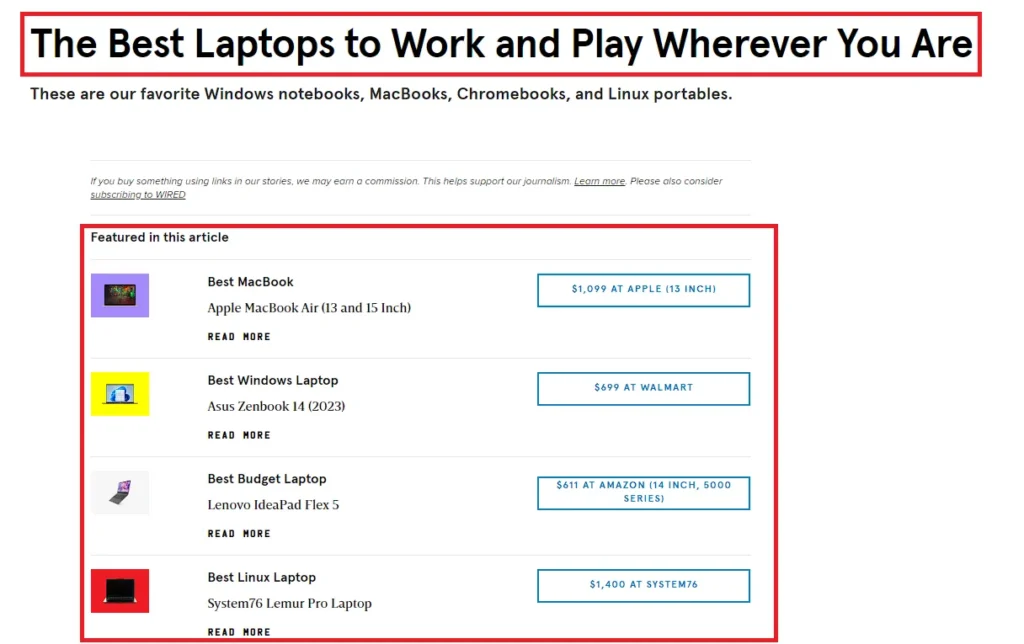
You can find such lists by searching the list’s name on Google. You can then reach out to the owner or the writer and ask him/her to add your website to that list.
Forums, communities, and Q&A sites
You can make use of forums and communities to get nofollow backlinks to your website.
Moreover, you can also use Q&A sites such as Quora to get backlinks by answering a question about your niche and smartly adding a link to your website.
Find unlinked brand mentions
This one is another quick link building technique.
Unlinked brand mention is when a website mentions your brand but doesn’t link to it.
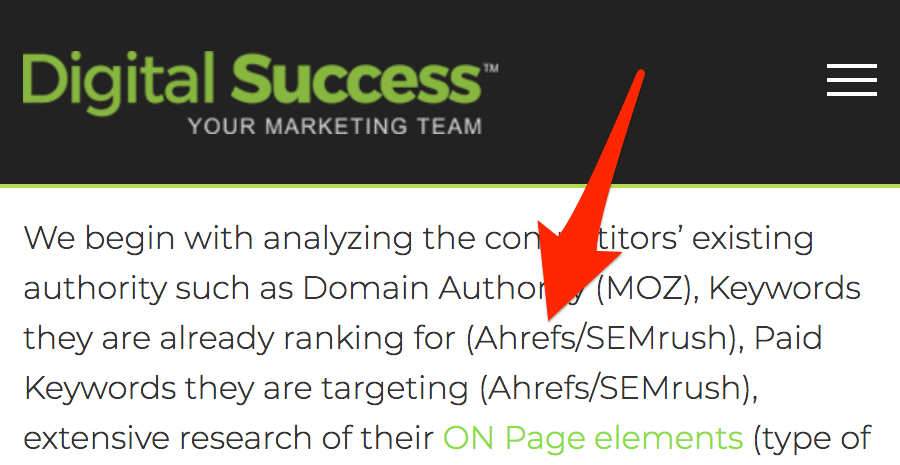
You can research and find out the websites that have mentioned your brand without any link and ask them to add your link.
5. Have you decided on who your outreach targets are
You see finding out and picking the best outreaching targets is crucial because that’s what determines the impact of your results.
You must find high domain authority websites in your niche that can give you backlinks which can really boost your rankings.
Here is a step-by-step process on how to do it:
What are the niches you are going to target
Your very first step is to identify all the niches that you want to target.
When trying to build links, you shouldn’t just try to target only your niche. Doing this would limit your opportunities to earn more links.
Instead, you can try to target your broader niche so that you can increase your number of opportunities while still being relevant to your niche.
For example, if you work in the software advice niche, instead of limiting yourself to software advice websites, you can target a broader niche like technology, and target all the websites that fall under that niche.
Which websites are you going to target in those niches
Once you’ve decided upon the niches you are going to target, your next job is to find websites in that niche.
One of the easiest ways to do this is by using Google.
Just type in your keyword with the word “websites” and hit the search button. The websites appearing on the result pages and the lists are your potential targets.

You can even type in a long tail keyword to find out more specific targets.
Where are your competitors getting links from
After you get the list of websites appearing in the search results for your keyword. Next, find out their competitors, aka similar websites, and add them to your list.
You can even make use of the competitor analysis you performed previously to find out the websites that are linking to your competitors and add them to your list.
Should I eliminate some websites from the list
Finally, once you gather a list of potential targets, it’s time to eliminate them.
You can use various metrics to filter out the best targets.
One such metric is “Domain authority/rating”.
Head over to a free domain authority checker tool like Ahrefs and enter the domain name of each website of your niche.
Go for the websites with high domain authority and eliminate other websites.
6. Which strategies are you going to use for building links
Now that you have the list of websites, it’s time to develop more efficient strategies to get links from these websites.
Remember the earlier goals for our link building process? It’s time to use it.
Your specific strategies should align with and be tailored to your goals and target websites.
What does it mean?
So, before you go for any option, you need to think about the goals you need to achieve.
For example, if your goal is to get backlinks to a specific website, you need to create a strategy that encourages the target website to send backlinks to that particular website
Next, you need to analyze your target website and understand the strategy that will encourage them to give you a link.
Here is a list of the most common link building techniques.
1. Links from guest posts – Find relevant target websites and offer them a free guest post in return for a link
2. Link from infographics – Create infographics, find targets, and offer them the infographics in return for a link
3. Links from HARO (now Connectively) – Visit the website, sign up as a source, provide information, and get a link
4. Links from broken links – Find websites linking to broken links and ask them to link to your similar content
5. Links from competitors’ backlinks – Spy on your competitors and take their links
6. Links from reviews – Get websites, bloggers, and influencers to review your product or service and add a link
7. Links from the information page – Create valuable content and promote it to get links
8. Links from free resources and tools – Create a free tool and promote it to get links
7. Do you have an outreach plan
Now let’s learn everything about outreaching for backlinks.
What is outreach
Outreach simply means reaching out or messaging your targets from whom you want to get backlinks.
How to outreach
Before sending any message, first practice writing a message.
The message should be written in a way that clearly explains to the target how you can help them and what you want in return.

You will find that it is never easy to get everyone to respond when you send them an outreach message.
A well-crafted message can increase your chances of getting a positive response.
Here’s how to outreach and write a message:
Step 1: Understand the goal
Your first job is to understand who your target is, what their brand tone is, who their customers are, what they need, and everything else.
Step 2: Write to match their vibe
Then, match their vibe.
Choose the outreach method that feels right for the website you’re aiming for, allow their voice to fit in your content, write down what they want to hear, and keep the length of the message short.
Step 3: Submit
Once you’ve created your message, review it and click the send button.
Step 4: Monitor the results
Finally, monitor results.
Make a list of all the messages you send to your targets.
Find and understand which outreach messages got a positive response, which got a negative response, which got none, and ask yourself why questions.
8. Have you decided upon why and how you are going to negotiate with your targets
Once you get a response from your outreach message, your next task is to negotiate and get a backlink.
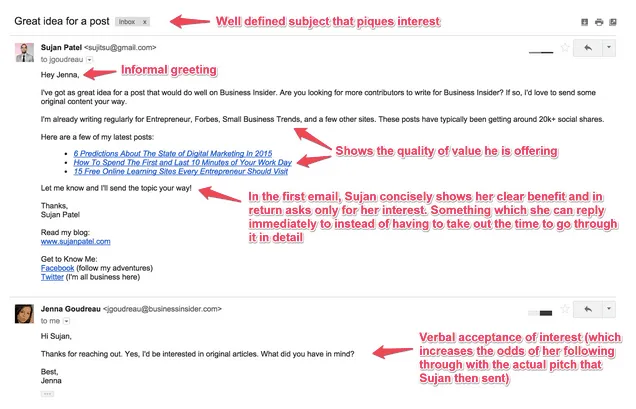
What should you negotiate for
When it comes to link building, the most important thing to negotiate for is the “Dofollow” link.
You’ll want to talk to the website owner about where you want to place your link, what page that link should include, what the anchor text should be, how many links you want, and so on.
Once you both agree on the terms, it’s time to get the backlink. And if you want to fast track the entire process you can outreach the work to blogger outreach services.
9. On what basis are you going to monitor and determine the quality of your results
Now, you must monitor the final results.
Once you receive the backlinks, you must then track your results and understand the effects of the backlinks on your goals.
Here’s how you can determine the quality of your backlinks:
Are your links from authoritative and reputable websites
The domain authority of your target website majorly decides the quality of your backlink.
A backlink from a high-authority website brings better results than a backlink from a low-authority website.
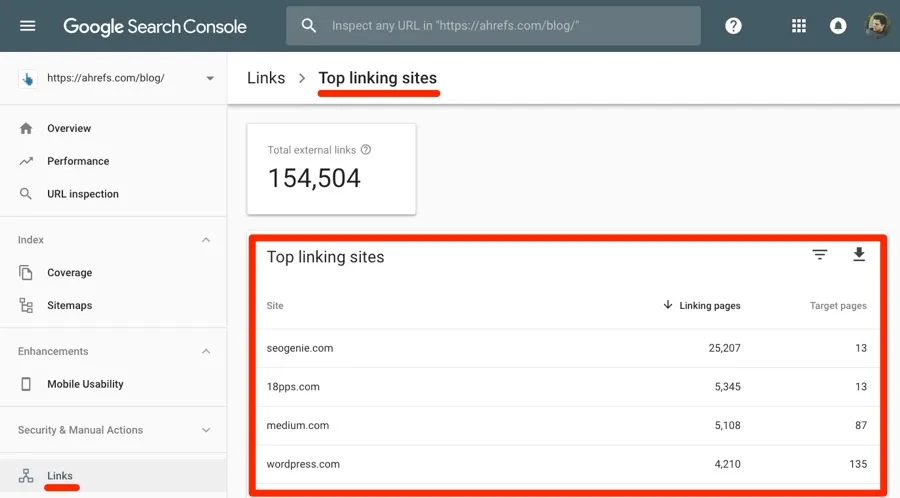
Is your link a “Dofollow” link
There are two types of links:
- Dofollow
- Nofollow
A Dofollow link passes the authority of the origin site to your website. Whereas, a No-follow link does not pass any authority and is just a normal backlink.
That’s why you must always try to get a Dofollow link from your target website.
Is the link coming from a website that is relevant to your niche
The relevancy of your target website to your niche also determines the quality of your link.
A link from the same niche website brings better results than a link from a website from another niche.
10. Do you have a diverse range of link sources
Well, you can’t just keep on building random links to your website. In order to rank higher on search engines, your backlink profile must have a diverse range of link sources.
Why? That is because Google considers the quality and variety of your backlinks when deciding upon your rankings.
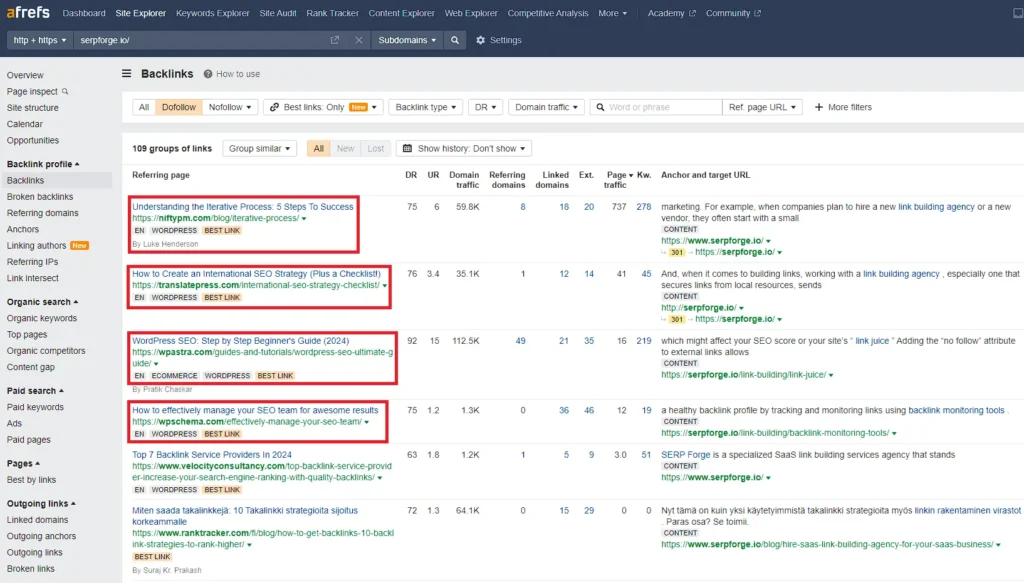
Furthermore, relying on a single type of links such as guest posting or directories can be risky. You never know when it may fall out of favor with search engines.
11. Are you adapting your strategy based on your results
Lastly, do remember to always adapt your strategy based on your results.
You see, not all strategies are going to work. Some might give you amazing results while others might fail to generate any links. In such cases, it’s always wise to adapt your strategies.
Analyze the results and decide what needs to be changed.
Explore until you find all the link building strategies or content types that generated the most links.
Once you’ve identified them, it’s time to change your other strategies and focus more on what works.
Conclusion
So this was a complete link building checklist.
Here is a quick overview of all the points covered in the checklist.
- Before setting any goals, you should analyze your current backlink profile
- Keep an eye on competitors’ backlinks
- If you are a beginner, you can go for quick backlink earning strategies
- Focus on targeting your niche websites
FAQs
-
Why do I need a link building checklist?
Having a link building checklist is like having a roadmap to your SEO success.
A link building checklist guides you through your link building process and ensures that you don’t skip any key steps in your link building process.
In short, it helps you do things better.
-
What happens if I don’t create a link building checklist?
If you haven’t made a link building checklist:
1. You may not be able to take advantage of opportunities
2. You can’t have a smooth link building process
3. You will not be consistent -
When should I start building links?
You should start building links as soon as you launch your website. Link building is not something where you have to wait for the right time to start. The earlier you start, the faster your website will grow.
